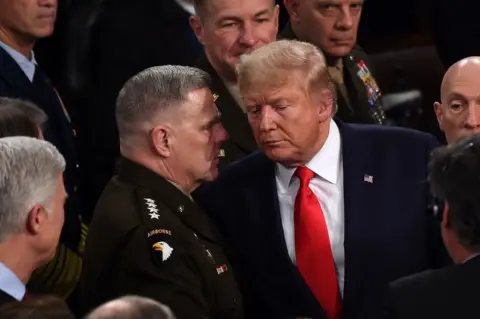What Trump indictment tells us about US security risks

 Getty Images
Getty ImagesThe US president stands at the apex of a huge intelligence community that gathers secrets from around the world.
Every morning some of the most sensitive material is distilled into documents personally briefed to the nation's leader.
But what kind of damage could be done by Donald Trump keeping hold of some of the secrets he was given?
Hundreds of files were retrieved from his Florida home and he now faces dozens of serious charges accusing him of illegally retaining classified information from his time in the White House. He denies any wrongdoing.
Prosecutors claim the unauthorised disclosure of some of the documents he kept could damage US security, relations with other countries and intelligence collection.
It is hard to say exactly how much damage would be done since the indictment, unsurprisingly, does not provide us with any of the specific, sensitive details.
We do know that the documents covered highly sensitive areas like military capabilities of other countries, including one on a country's nuclear means. And details about US military contingency planning and intelligence on other countries, including their leaders.
"Even the brief description of the documents' contents and the classified markings make it clear that these were some of the nation's most sensitive secrets," Glenn Gerstell, a former general counsel of the National Security Agency, told the BBC.
Some were more secret than others.
A few were not just Top Secret (which means exposure of the information could cause "exceptionally grave damage" to national security) but also subject to other higher clearances or special handling requirements. In fact in some cases, even the marking detailing the level of classification is itself redacted or classified in the indictment of Trump.
There are lots of ways the material could potentially cause damage if it was revealed to a wider audience.
Some of the markings on the documents indicate they may have derived from human sources of technical intercepts. If this material gets out, it might then allow another country to find the human spy or close down the vulnerability which allows their communications to be intercepted, in turn cutting off that flow of intelligence.
It could also cause embarrassment or problems for allies by revealing their secrets. And of course, material could reveal secrets about the US's own military or other capabilities that would be useful to adversaries.
"What battle plans or strategies now might have to be changed if we fear they have been revealed?" asks Mr Gerstell.

More coverage

Some of the material could relate to allies of the US - either information about them or collected by them.
One of the documents is marked SECRET//REL TO USA, FVEY - the latter marking means it can be released to the Five Eyes community of the US, UK, Canada, New Zealand and Australia rather than being about them and likely means it is not as sensitive as those listed as NOFORN which are for US eyes only.
America's allies know that Washington can be leaky but they also know better than to complain given that they rely on the vastly greater volume of information it produces.
The real damage would come if the documents were not just retained but disclosed to people. And it is true that plenty of other sensitive documents have been publicly leaking from US intelligence recently - most notably the so-called Discord or Pentagon leaks this year in which documents were distributed widely on a social media platform.
But it is Donald Trump's behaviour that has led to concern that the risks are not just hypothetical.
In July 2021, a writer and a publisher came to see the former president regarding an upcoming book. In the meeting, Trump discusses having retained a plan of attack on another country - only named as country A in the document but thought to be Iran. He shows the document to the visitors and says it is "still a secret", according to the indictment.
That incident highlights the twin concerns about Mr Trump - a willingness not just to keep classified material but also to talk about it.
 Getty Images
Getty ImagesWe don't know his motive but it seems to have been to boast to people he knew rather than to wilfully damage security by giving the material to those who wish the US harm. But that does not prevent the possibility of damage.
His looseness surrounding highly sensitive intelligence material dated from his earliest time in office.
In May 2017, he revealed to the visiting Russian foreign minister highly classified details of a counter-terrorist operation apparently carried out by Israel.
In another case, he apparently tweeted a picture he took of a satellite image of an Iranian missile launch site following a briefing.
And even if he had not himself been loose with the documents, the way they were stored at Mar-a-Lago and his Bedminster golf club made them inherently vulnerable to someone, including foreign spies.
"Any time secret documents aren't stored properly, the government worries that some foreign agent might have been able to see them," says Mr Gerstell.
"So they have to make a 'worse case' assumption and figure out what are the chances that an adversary could discover which mole revealed information to the US or which computer networks need to be plugged up so the US can't keep on intercepting emails or other communications."
The heart of the indictment against Trump is less about the specific sensitivities of documents but rather the pattern of behaviour when asked to return the documents. But it is only because of just how secret the documents are that this behaviour matters so much.
